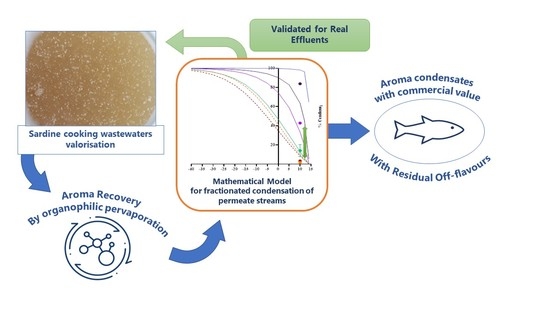Recovery of Valuable Aromas from Sardine Cooking Wastewaters by Pervaporation with Fractionated Condensation: Matrix Effect and Model Validation
Abstract
:1. Introduction
2. Materials and Methods
3. Results
3.1. Characterisation of Sardine Cooking Wastewaters
3.2. Pervaporation-Fractionated Condensation Processing of Sardine Cooking Wastewaters
Model Validation for the Real Sardine Cooking Wastewater
4. Conclusions
Author Contributions
Funding
Institutional Review Board Statement
Informed Consent Statement
Data Availability Statement
Conflicts of Interest
References
- Trifunović, O.; Lipnizki, F.; Trägårdh, G. The influence of process parameters on aroma recovery by hydrophobic pervaporation. Desalination 2006, 189, 1–12. [Google Scholar] [CrossRef]
- Schäfer, T.; Crespo, J.G. Recovery of aroma compounds from fermentation by pervaporation. Environ. Prot. Eng. 1999, 25, 73–85. [Google Scholar]
- Martínez, R.; Sanz, M.T.; Beltrán, S. Pervaporation investigation of recovery of volatile compounds from brown crab boiling juice. Food Sci. Technol. Int. 2014, 20, 511–526. [Google Scholar] [CrossRef]
- Schäfer, T.; Bengtson, G.; Pingel, H.; Böddeker, K.W.; Crespo, J. Recovery of aroma compounds from a wine-must fermentation by organophilic pervaporation. Biotechnol. Bioeng. 1999, 62, 412–421. [Google Scholar] [CrossRef]
- Souchon, I.; Pierre, F.X.; Marin, M. Pervaporation as a deodorization process applied to food industry effluents: Recovery and valorisation of aroma compounds from cauliflower blanching water. Desalination 2002, 148, 79–85. [Google Scholar] [CrossRef]
- Figoli, A.; Tagarelli, A.; Cavaliere, B.; Voci, C.; Sindona, G.; Sikdar, S.K.; Drioli, E. Evaluation of pervaporation process of kiwifruit juice by SPME-GC/Ion Trap Mass Spectrometry. Desalination 2010, 250, 1113–1117. [Google Scholar] [CrossRef]
- Pereira, M.J.; Brazinha, C.; Crespo, J.G. Pervaporation recovery of valuable aromas from by-products of the seafood industry: Modelling of fractionated condensation for off-flavour removal. Sep. Purif. Technol. 2022, 286, 120441. [Google Scholar] [CrossRef]
- Soares, L.S.; Vieira, A.C.F.; Fidler, F.; Nandi, L.G.; Monteiro, A.R.; Di Luccio, M. Volatile Organic Compounds Profile Obtained from Processing Steps of Pacific Oysters (Crassostrea gigas) as Perspective for Food Industry. J. Aquat. Food Prod. Technol. 2020, 29, 194–206. [Google Scholar] [CrossRef]
- Ridgway, K.; Lalljie, S.P.D.; Smith, R.M. Analysis of food taints and off-flavours: A review. Food Addit. Contam. 2010, 27, 146–168. [Google Scholar] [CrossRef] [Green Version]
- Pereira, M.J.; Grosjean, O.; Pintado, M.; Brazinha, C.; Crespo, J. Clean Technologies for Production of Valuable Fractions from Sardine Cooking Wastewaters: An Integrated Process of Flocculation and Reverse Osmosis. Clean Technol. 2022, 4, 276–295. [Google Scholar] [CrossRef]
- Schafer, T. Recovery of Wine-Must Aroma by Pervaporation. Ph.D. Thesis, Universidade Nova de Lisboa, Caparica, Portugal, 2002. [Google Scholar]
- Kujawska, A.; Knozowska, K.; Kujawa, J.; Kujawski, W. Influence of downstream pressure on pervaporation properties of PDMS and POMS based membranes. Sep. Purif. Technol. 2016, 159, 68–80. [Google Scholar] [CrossRef]
- Martínez, R.; Sanz, M.; Beltrán, S.; Teresa Sanz, M.; Beltrán, S. Concentration by pervaporation of brown crab volatile compounds from dilute model solutions: Evaluation of PDMS membrane. J. Memb. Sci. 2013, 428, 371–379. [Google Scholar] [CrossRef] [Green Version]
- Ganeko, N.; Shoda, M.; Hirohara, I.; Bhadra, A.; Ishida, T.; Matsuda, H.; Takamura, H.; Matoba, T. Analysis of volatile flavor compounds of sardine (Sardinops melanostica) by solid phase microextraction. J. Food Sci. 2008, 73, S83–S88. [Google Scholar] [CrossRef]
- Mansur, M.A.; Bhadra, A.; Takamura, H.; Matoba, T. Volatile flavor compounds of some sea fish and prawn species. Fish. Sci. 2003, 69, 864–866. [Google Scholar] [CrossRef]

| Aroma Compounds | Area * | [Ci] (ppm) * | Aroma Compounds | Area * | [Ci] (ppm) * |
|---|---|---|---|---|---|
| Aldehydes | Alcohols | ||||
| Hexanal | 123246866 | 1-Penten-3-ol | 79964041 | 0.100 | |
| Heptanal | 28381616 | 0.006 | 1-Octen-3-ol | 181778114 | 0.008 |
| 2-Hexenal, (E)- | 58129859 | (5Z)-Octa-1,5-dien-3-ol | 86516933 | ||
| Octanal | 16922895 | 2-Ethylhexanol | 7501041 | ||
| Nonanal | 79342642 | 1-Octanol | 590437999 | 0.100 | |
| 2-Octenal, (E)- | 39611501 | 1-Penten-3-ol | 79964041 | 0.008 | |
| 2,4-Heptadienal, (E,E)- | 88078708 | 1-Octen-3-ol | 181778114 | ||
| 2-Nonenal, (E)- | 21644129 | 0.011 | Ketones | ||
| 2,6-Nonadienal, (E,Z)- | 92347778 | 0.044 | 2-Nonanone | 44929994 | 0.001 |
| 2-Decenal, (E)- | 12169097 | 3,5-Octadien-2-one | 113901449 | ||
| Sulphur compounds | 2-Undecanone | 8019036 | |||
| Trans-2-(2-Pentenyl)furan | 46428766 | Acids | |||
| Hexanoic acid | 89583410 | ||||
| Compound | Ji [mol/m2.s] | Li [mol/(m.s.Pa)] | Separation Factor [–] |
|---|---|---|---|
| Sardine cooking wastewater | |||
| 1-Penten-3-ol | 6.58 × 10−7 ± 8.64 × 10−9 | 6.25 × 10−11 ± 4.15 × 10−12 | 4.20 ± 0.28 |
| 1-Octen-3-ol | 3.91 × 10−8 ± 1.66 × 10−9 | 2.33 × 10−11 ± 7.95 × 10−13 | 11.19 ± 0.38 |
| 2-Nonanone | 1.89 × 10−8 ± 9.67 × 10−10 | 1.48 × 10−11 ± 9.17 × 10−13 | 51.03 ± 3.14 |
| Heptanal | 2.80 × 10−8 ± 9.56 × 10−10 | 3.73 × 10−12 ± 3.06 × 10−13 | 7.31 ± 0.60 |
| (E2, Z6)-Nonadienal | 4.65 × 10−7 ± 2.86 × 10−8 | 1.48 × 10−11 ± 9.17 × 10−13 | 171.15 ± 19.73 |
Publisher’s Note: MDPI stays neutral with regard to jurisdictional claims in published maps and institutional affiliations. |
© 2022 by the authors. Licensee MDPI, Basel, Switzerland. This article is an open access article distributed under the terms and conditions of the Creative Commons Attribution (CC BY) license (https://creativecommons.org/licenses/by/4.0/).
Share and Cite
Pereira, M.J.; Pintado, M.; Brazinha, C.; Crespo, J. Recovery of Valuable Aromas from Sardine Cooking Wastewaters by Pervaporation with Fractionated Condensation: Matrix Effect and Model Validation. Membranes 2022, 12, 988. https://doi.org/10.3390/membranes12100988
Pereira MJ, Pintado M, Brazinha C, Crespo J. Recovery of Valuable Aromas from Sardine Cooking Wastewaters by Pervaporation with Fractionated Condensation: Matrix Effect and Model Validation. Membranes. 2022; 12(10):988. https://doi.org/10.3390/membranes12100988
Chicago/Turabian StylePereira, M. João, Manuela Pintado, Carla Brazinha, and João Crespo. 2022. "Recovery of Valuable Aromas from Sardine Cooking Wastewaters by Pervaporation with Fractionated Condensation: Matrix Effect and Model Validation" Membranes 12, no. 10: 988. https://doi.org/10.3390/membranes12100988







